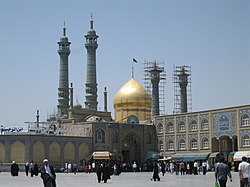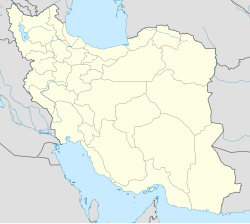Qom
The "Scots" that wis uised in this airticle wis written bi a body that haesna a guid grip on the leid. Please mak this airticle mair better gin ye can. (Dizember 2020) |
Qom قم | |
|---|---|
 | |
| Coordinates: 34°38′24″N 50°52′35″E / 34.64000°N 50.87639°E | |
| Kintra | |
| Province | Qom |
| Coonty | Qom |
| Bakhsh | Central |
| Population (2010) | |
| • Total | 1,233,000 |
| Time zone | UTC+3:30 (IRST) |
Qom (Persie: قم, kent as Q'um or Ghom an aw) is a ceety in Iran. It lies 156 kilometres (97 mi) bi road soothwast o Tehran an is the caipital o Qom Province. It haes an estimatit population o 1,042,309 in 2005. It is situatit on the banks o the Qom River.
Qom is considered holy bi Shi`a Islam, as it is the site o the shrine o Fatema Mæ'sume, sister o Imam `Ali ibn Musa Rida (Persian Imam Reza, 789–816 AD). The ceety is the lairgest centre for Shi'a scholarship in the warld, an is a significant destination o pilgrimage.
History
[eedit | eedit soorce]Qom as an urban dounset existit in the pre-Islamic ages. Architectural discoveries indicate that Qom wis a residential aurie frae the 5t millennium BC. Pre-Islamic remainin relics an historical texts pynt tae the fact o Qom bein a lairge regional ceety. Kum wis kent tae be the name o this auncient ceety, sicweys, the incomin 7t century Arabs cried it Qom durin the conquests o Iran.
Durin the caliphate o ʻUmar ibn al-Khattāb, the aurie o Qom fell tae the invadin Arab airmies o Islam. In 645 AD, Abu Musa Ash'ari dispatched forces unner his command tae the aurie an aw. Conflicts resultit atween the incomin Arab airmy an the residents o the aurie.
In Seljuki times, the ceety flourished as well. Durin the Mongol invasion o Persie the ceety witnessed widespread destruction, but efter the Mongol rulin dynasty, kent as the Ilkhanate an aw, convertit tae Islam durin the reign o Öljeitü (Persian Muhammad Khudabænde), the ceety received special attention, sicweys unnergoin a revival ance mair.
In the late 14t century, the ceety wis plundered bi Tamerlane an the indwallers wur massacred. But durin the periods o rule o the Qara Qoyunlu, Aq Qoyunlu an especially durin the reign o the Safavids, Qom gained special attention an gradually developed due tae its releegious shrine.

Bi 1503 Qom became ane o the important centers o theology in relation tae the Shia Islam, an became a significant religious pilgrimage site an pivot.
The ceety suffered hivy damages again durin the Afghan invasions, resultin in consequent severe economic haurdships. Qom further sustained damages durin the reigns o Nadir Shah an the conflicts atween the twa hoosehaulds o Zandieh an Qajariyeh in order tae gain pouer ower Iran.
Finally in 1793 Qom came unner the control o Agha Muhammad Khan Qajar. On bein victorious ower his enemies, the Qajar Sultan Fæteh Æli Shah wis responsible for the repairs done on the sepulchre an Holy Shrine o Hæzræt Mæ'sume, as he haed made sic a vou.
The ceety o Qom began anither era o prosperity in the Qajar era. Efter Roushie forces entered Karaj in 1915, mony o the indwallers o Tehran moved tae Qom due tae reasons o proximity, an the transfer o the caipital frae Tehran tae Qom wis even discussed. But the Breetish an Roushies defeatit prospects o the plan bi putting Ahmad Shah Qajar unner poleetical pressure. Coinciding wi this period, a "National Defense Committee" wis set up in Tehran, an Qom turned intae a poleetical an military apex opposed tae the Roushie an Breetish colonial powers.
As a centre o releegious learnin Qom fell intae decline for aboot a century frae 1820 tae 1920, but haed a resurgence when Shaykh Abdul Karim Haeri Yazdi acceptit an invitation tae muive frae Sultanabad (nou cried Arak, Iran), whaur he haed been teachin, tae Qom.[1]
In 1964 an 65, afore his exile frae Iran, the Ayatollah Khomeini led his opposition tae the Pahlavi dynasty frae Qom. Efter the Islamic revolution in 1979, Khomeini forby spent some time in the ceety afore an efter movin tae Tehran.
Qom today
[eedit | eedit soorce]Template:Twelvers The day, Qom is coontit as ane o the focal centers o the Shi'a baith in Iran an aroond the globe. Syne the revolution the clerical population haes risen frae aroond 25,000 tae mair nor 45,000 an the nonnclerical population haes mair nor tripled tae aboot 700,000. Substantial sums o money in the form o alms an Islamic taxes flow intae Qom tae the ten marja-i taqlid or "Source o Imitation" that reside thare.[2] The nummer o seminary schools in Qom is nou ower 50, an the nummer o research institutes an libraries somewhere near 250.[2]
Its theological centre an the Fatima al-Masumeh Shrine are prominent features o the provincial caipital o Qom province. Anither vera popular releegious site o pilgrimage umwhile ootside the ceety o Qom but nou mair o a suburb is cried Jamkaran.
Qom's proximity tae Tehran, Iran's caipital, haes alloued the clerical establishment easy access tae monitor the affairs an decisions o the state. Mony grand ayatollahs hauld offices in baith Tehran an Qom; mony fowk simply commute atween the twa ceeties as thay are anerlie 156 km apairt.
Nearbi Touns
[eedit | eedit soorce]Sootheast o Qom is the auncient ceety o Kashan. Directly sooth o Qom lie the touns o Delijan, Mahallat, Naraq, Kahak, an Jasb. The surroondin aurie tae the east o Qom is populatit bi Tafresh, Saveh, an Ashtian an Jafarieh.
References
[eedit | eedit soorce]| Wikimedia Commons haes media relatit tae Qom. |
